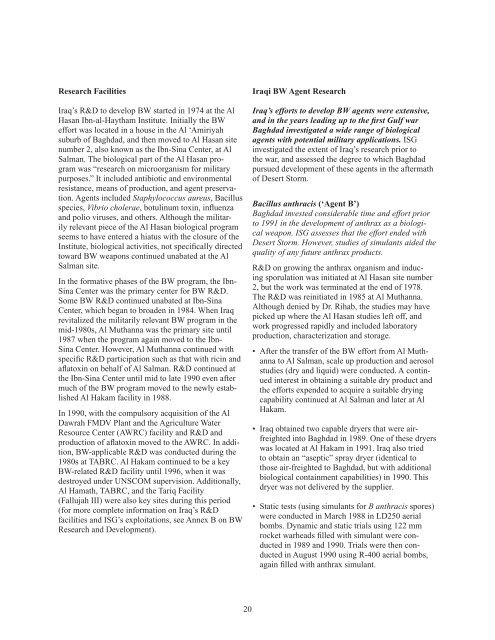Comprehensive Report
GPO-DUELFERREPORT-3
GPO-DUELFERREPORT-3
- No tags were found...
You also want an ePaper? Increase the reach of your titles
YUMPU automatically turns print PDFs into web optimized ePapers that Google loves.
Research Facilities<br />
Iraq’s R&D to develop BW started in 1974 at the Al<br />
Hasan Ibn-al-Haytham Institute. Initially the BW<br />
effort was located in a house in the Al ‘Amiriyah<br />
suburb of Baghdad, and then moved to Al Hasan site<br />
number 2, also known as the Ibn-Sina Center, at Al<br />
Salman. The biological part of the Al Hasan program<br />
was “research on microorganism for military<br />
purposes.” It included antibiotic and environmental<br />
resistance, means of production, and agent preservation.<br />
Agents included Staphylococcus aureus, Bacillus<br />
species, Vibrio cholerae, botulinum toxin, influenza<br />
and polio viruses, and others. Although the militarily<br />
relevant piece of the Al Hasan biological program<br />
seems to have entered a hiatus with the closure of the<br />
Institute, biological activities, not specifically directed<br />
toward BW weapons continued unabated at the Al<br />
Salman site.<br />
In the formative phases of the BW program, the Ibn-<br />
Sina Center was the primary center for BW R&D.<br />
Some BW R&D continued unabated at Ibn-Sina<br />
Center, which began to broaden in 1984. When Iraq<br />
revitalized the militarily relevant BW program in the<br />
mid-1980s, Al Muthanna was the primary site until<br />
1987 when the program again moved to the Ibn-<br />
Sina Center. However, Al Muthanna continued with<br />
specific R&D participation such as that with ricin and<br />
aflatoxin on behalf of Al Salman. R&D continued at<br />
the Ibn-Sina Center until mid to late 1990 even after<br />
much of the BW program moved to the newly established<br />
Al Hakam facility in 1988.<br />
In 1990, with the compulsory acquisition of the Al<br />
Dawrah FMDV Plant and the Agriculture Water<br />
Resource Center (AWRC) facility and R&D and<br />
production of aflatoxin moved to the AWRC. In addition,<br />
BW-applicable R&D was conducted during the<br />
1980s at TABRC. Al Hakam continued to be a key<br />
BW-related R&D facility until 1996, when it was<br />
destroyed under UNSCOM supervision. Additionally,<br />
Al Hamath, TABRC, and the Tariq Facility<br />
(Fallujah III) were also key sites during this period<br />
(for more complete information on Iraq’s R&D<br />
facilities and ISG’s exploitations, see Annex B on BW<br />
Research and Development).<br />
Iraqi BW Agent Research<br />
Iraq’s efforts to develop BW agents were extensive,<br />
and in the years leading up to the first Gulf war<br />
Baghdad investigated a wide range of biological<br />
agents with potential military applications. ISG<br />
investigated the extent of Iraq’s research prior to<br />
the war, and assessed the degree to which Baghdad<br />
pursued development of these agents in the aftermath<br />
of Desert Storm.<br />
Bacillus anthracis (‘Agent B’)<br />
Baghdad invested considerable time and effort prior<br />
to 1991 in the development of anthrax as a biological<br />
weapon. ISG assesses that the effort ended with<br />
Desert Storm. However, studies of simulants aided the<br />
quality of any future anthrax products.<br />
R&D on growing the anthrax organism and inducing<br />
sporulation was initiated at Al Hasan site number<br />
2, but the work was terminated at the end of 1978.<br />
The R&D was reinitiated in 1985 at Al Muthanna.<br />
Although denied by Dr. Rihab, the studies may have<br />
picked up where the Al Hasan studies left off, and<br />
work progressed rapidly and included laboratory<br />
production, characterization and storage.<br />
• After the transfer of the BW effort from Al Muthanna<br />
to Al Salman, scale up production and aerosol<br />
studies (dry and liquid) were conducted. A continued<br />
interest in obtaining a suitable dry product and<br />
the efforts expended to acquire a suitable drying<br />
capability continued at Al Salman and later at Al<br />
Hakam.<br />
• Iraq obtained two capable dryers that were airfreighted<br />
into Baghdad in 1989. One of these dryers<br />
was located at Al Hakam in 1991. Iraq also tried<br />
to obtain an “aseptic” spray dryer (identical to<br />
those air-freighted to Baghdad, but with additional<br />
biological containment capabilities) in 1990. This<br />
dryer was not delivered by the supplier.<br />
• Static tests (using simulants for B anthracis spores)<br />
were conducted in March 1988 in LD250 aerial<br />
bombs. Dynamic and static trials using 122 mm<br />
rocket warheads filled with simulant were conducted<br />
in 1989 and 1990. Trials were then conducted<br />
in August 1990 using R-400 aerial bombs,<br />
again filled with anthrax simulant.<br />
20


